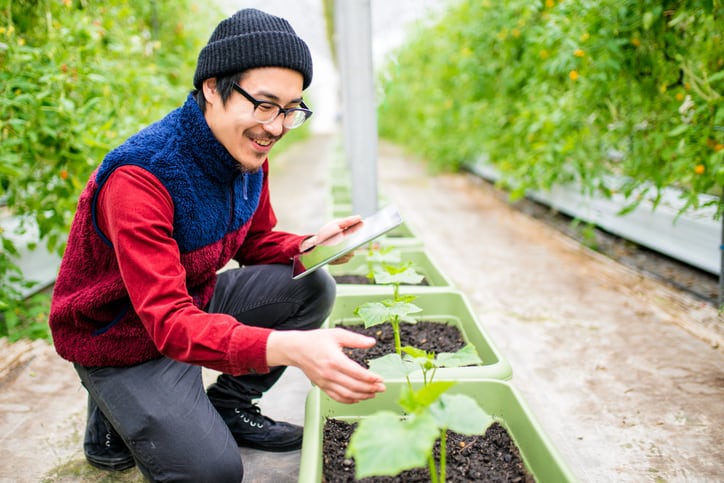ATN: What is multiomics and how is it increasingly being used to understand and enhance agricultural efficiency?
PB: Multiomics involves the biological analysis of cells through several methods including genomics, proteomics, transcriptomics or metabolomics. The combination of analyses helps researchers to study target systems from both a top-down and bottom-up approach. In the context of agricultural studies, understanding the specific traits that confer drought resistance, for example, seed oil content, plant biomass levels or other aspects, is critical in increasing productivity and resilience.
Identifying and understanding these traits requires a comprehensive analysis of not only the genomic elements but also the proteome, transcriptome and metabolite level that impact phenotypic variations. Such genotype-to-phenotype studies allow not just for identifying a specific genetic element (responsible for blight resistance, for example), but in understanding how these elements are regulated at the transcriptome and proteome level. These studies also indicate which target metabolites are key to resistance or are exacerbated in the given condition.
Such level of knowledge is increasingly being used by agricultural scientists to develop novel variants to improve crops using synthetic biology techniques and genome editing tools.
ATN: What advances in next-generation sequencing (NGS) support analysis of plants to gain insights into aspects such as senescence and responses to biotic and abiotic influences?
PB: Quantitative Trait Loci (QTL) mapping and Genome Wide Association studies (GWAS) are two methods utilised to study and understand different traits in crops and seeds. QTL mapping allows for connecting genomic elements to phenotypic traits and GWAS can help identify variants that are associated with these traits. Advances in whole genome sequencing approaches utilising NGS chemistries help genome-wide studies and single nucleotide polymorphism (SNP) identification.
Additionally, exome sequencing can help identify the transcriptomic profile of the plant displaying a target trait. Further analysis using methylation sequencing techniques, for example, can also generate data for epigenomic profiling of the target crop. The large amount of data generated by such NGS profiling is used to statistically relate proteomic and metabolomic information to understand how environmental factors can impact growth, survival and fitness of different crops and crop variants.
ATN: What methods are researchers using to improve crop genetics and animal breeding science, to make agricultural output more resilient to pests and the effects of climate change?
PB: The role of GWAS studies has been integral in connecting crop genetics and animal breeding to the effects of climate change. GWAS studies have identified multiple traits in maize, for example, that allow the plant to modulate yield during hot and cold climate stresses. GWAS studies have identified SNPs in sorghum and rice that relate to drought resistance and tolerance. Researchers have used CRISPR (clustered regularly interspaced short palindromic repeats) and TALEN (transcription activator-like effector nucleases) based genome editing techniques to confer mildew resistance to wheat and prevent fungal infection in tomatoes.
Studies to investigate mutation events that may confer specific genetic traits to target crops have also helped improve resilience to pests. Targeted induced local lesions in genomes (TILLING) studies, for example, are used to induce and characterise mutagenesis in a high-throughput format in target seeds and crops. Finally, microarray-based studies have also been developed to target transcriptomic edits and develop desirable variations.

ATN: How is NGS supported by advances in technology to provide analyses of millions of cells in a single study?
PB: There are a number of technologies that have allowed for the advancement of NGS in supporting single-cell sequencing approaches. Traditional flow cytometry-based techniques continue to be utilised when trying to get single-cell-specific sequencing data. Recently, microfluidics and microdroplet supported technologies have helped shape the single-cell sequencing space. Using microfluidics and bead-based labelling, cells can be uniquely barcoded to get single-cell-specific genomic and transcriptomic data. Crossing this approach with tissue cross-sectioning and imaging analysis can give greater in-depth detail of how certain genetic elements are activated in specific cell types and regions. More recent advances have looked to specifically develop emulsified labelled single cells without the need for microfluidic instrumentation.
Another technology is the use of combinatorial indexing. Here, cells or even sub-cellular components such as nuclei are passed through pools of barcoded wells that uniquely label cells and their analytes. The combinatorial labeling ensures each cell is uniquely barcoded without the need for partitioning.
Finally, charged nanodroplet-based techniques are currently being explored in the single-cell NGS space. In this technique, single cells in a nanodrop are channeled between 2 electrodes, which then uses an electric potential to allow gene-editing modifications of target cells. The technique allows reactions to occur in a 5-to-10-fold reduced volume, thus lowering reagent usage and cost, and allows for screening of a large number of arrayed targets in a very short time.
ATN: What part does automation of cell sequencing play in the development of agricultural yields and tackling global food production?
PB: The huge amounts of data being generated through NGS and other omics-based applications, the need to study multiple traits with gene editing, and the phenotypic analysis required for verification are all increasing the need for high-throughput automation in the agricultural space. There are also the pressures to increase agricultural yields, minimise environmental and climate change impacts, protect plants and animals from disease, as well as the need to keep produce fresh for longer.
Due to such requirements and advancements in analytical techniques, more researchers and companies are using automation to speed up time to results. As the agricultural industry is highly cost-sensitive, there is a significant need to reduce library preparation volumes. An increased focus on miniaturisation of NGS library preparation is being pursued by chemistry vendors and automation providers, enabling increased sampling and data generation.
Automation also increases throughput and reduces manual testing time by researchers. Data generation can continue 24 hours per day without the need for interventions. Additionally, multiple omics-specific samples can be prepared and analysed with a single input. Such developments are continuing to put pressure on tools needed for data storage and data analytics.
ATN: What successes have been seen in crops and animal science using these techniques?
PB: Tomelo is a tomato which has a gene deletion that allows it to be resistant to fungal pathogens. This lets the tomato remain fresh for days. The seeds are non-transgenic and are already being used. In animals, these techniques have so far been used less, but data from GWAS studies, for example, is used to reduce in-breeding among cattle. In this way, genetic diversity is maintained in the population. This also leads to a reduction in disease of in-bred cattle populations and prevention of loss of fitness.
Overall advances in technology and the automation of processes to drive scientific discovery are enabling agricultural researchers to ascertain how crops and animal breeding can be optimised to support global food production.


